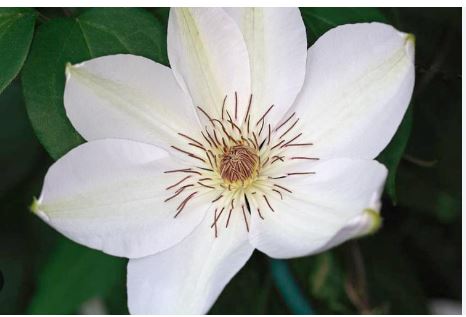
Clematis ‘Henryi’ is one of the classic large-flowered clematis hybrids. It was named after the German botanist and plant collector Augustine Henry, who was instrumental in bringing many plants from China to the Western world in the late 19th and early 20th centuries. However, the cultivar ‘Henryi’ itself was bred by Isaac Anderson-Henry, a Scottish nurseryman, in the late 1850s or 1860s. This cultivar has been appreciated for its large, striking flowers and has been a favorite in gardens for well over a century.
Characteristics
- Flowers: Clematis ‘Henryi’ boasts very large, white or off-white flowers, which can be up to 6-8 inches (15-20 cm) in diameter. Each flower typically has 6 to 8 sepals with pointed tips, and the center boasts contrasting dark anthers, usually brown or dark red, giving the flowers a striking appearance.
- Growth Habit: ‘Henryi’ is a moderately vigorous climber, reaching heights of about 8 to 12 feet (2.5 to 3.5 meters). It’s less rampant than some other varieties, making it suitable for smaller gardens or for growing in containers with support.
- Bloom Time: It flowers on the previous year’s growth in late spring to early summer, with sometimes a lighter bloom in late summer or early fall on new growth.
- Foliage: The leaves are green, typically with a somewhat pointed shape, providing a lush background to the white blooms.
- Pruning Group: Belongs to Pruning Group 2. This means it should be pruned lightly in late winter or early spring by removing dead or weak stems, and then again lightly after the first flush of flowers to encourage a second blooming.
Cultivation
- Sunlight: Prefers full sun to partial shade. While it can tolerate some shade, for the best flowering, a position where the plant receives at least 6 hours of sunlight is ideal, with the roots in shade.
- Soil: Requires well-drained, fertile soil, enriched with organic matter. Like most clematis, it prefers a neutral to slightly alkaline soil pH.
- Watering: Needs regular watering to keep the soil moist but not waterlogged. Consistent moisture is particularly important during the growing season.
- Planting: Plant ‘Henryi’ with the base of the plant 2-3 inches below the soil surface. This helps in protecting against clematis wilt and encourages the plant to produce more shoots from below the soil level.
- Support: Provide a trellis, arbor, or other support structures for it to climb. It can also be trained to grow through shrubs or small trees.
- Mulching: Mulch around the plant to keep the roots cool, retain moisture, and reduce weed growth.
- Fertilization: Feed with a balanced fertilizer in spring, and you might add a high-potash fertilizer after the first bloom to encourage further flowering.
- Diseases: Like other clematis, it can be susceptible to clematis wilt. Good air circulation, proper planting depth, and avoiding overhead watering can help prevent this.
- Winter Care: In colder climates, provide some mulch around the base for protection after pruning.